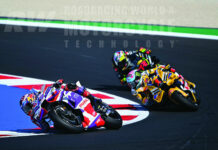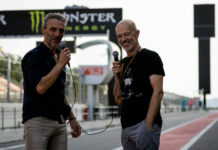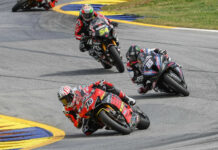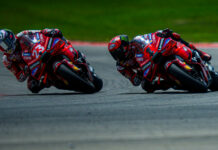TRACK FACTS The magnificent Sepang circuit complex was constructed close to Kuala Lumpur International airport, around 50kms south of the capital city, in 1998. Built with Formula One cars in mind, the long 5.548km circuit contains a variety of bends and undulations and a 920 metre start and finish straight which runs parallel with an almost as long straight which is linked to the main straight by a first gear left-hand hairpin. The circuit is famous for its enormous grandstands, featuring hibiscus (the national flower of Malaysia) style roofs which dominate both straights and for the humidity and weather changes. It’s always very hot and humid for the riders and teams and often in the afternoon very heavy short sharp thundery showers can fall, just to make practice, qualifying and racing even more demanding. The Malaysian Grand Prix was first staged at the bumpy and tight Shah Alam circuit in Kuala Lumpur in 1991 and stayed there until 1998 when it switched for one year to Johor. In 1999 it was held at Sepang for the first time and Kenny Roberts won the race for Suzuki and repeated his victory the following year en route to the World 500cc Championship. Since then the race has been dominated by Italians with Valentino Rossi winning in 2001, 2003 and 2004. Max Biaggi brought Yamaha victory in 2002 after a tremendous battle with Rossi and Alex Barros, who’d started in pole. Biaggi was third the next year and second last year both times riding the Camel Honda. Last year Alex Barros was third behind Rossi and Biaggi. As the team await the return of Troy Bayliss, and after last weekend’s appearance of HRC’s official rider Tohru Ukawa, Shane Byrne will ride in Camel Honda team colours for the next two events. FROM THE SADDLE Alex Barros #4: “Sepang is one of the most physically challenging circuits on the calendar, as is Qatar. The heat and humidity are incredible for both the riders and the bike. Sometimes the engine gets so hot that it burns your hands and feet! Such extreme conditions are also a tough test for the tyres, as well as the engine and the suspension but we had some really good tests there in preseason and we already have a good base set-up to start from. I want to have a good race so that I can recover some points in the championship so hopefully we can start well from the first free practice on Friday”. Shane Byrne #67: “I thought my season was over but now I have this fantastic chance to ride a Honda, I still can’t believe it. It will be tough because everybody has high expectations but I’m determined not to waste this opportunity. I have never raced in Malaysia but I did test there with Aprilia. It is a technical circuit and I like it but until I ride there on the RC211V I don’t know what to expect. I have only ever dreamed of riding a bike like this.” CIRCUIT – MALAYSIAN GRAND PRIX – 25/09/05 SEPANG Track data Length: 5.548kms Pole position: Left Width: 25m Right corners: Ten Left corners: Five Longest straight: 920m Constructed 1998 Record lap: Valentino Rossi (Yamaha) 2:03.253 – 162.047 km/h Record Pole lap: Valentino Rossi (Yamaha) 2:01.833 – 101.865 km/h 2004 Race winner: Valentino Rossi (Yamaha) 43:29.146 – 160.753 km/h Alex Barros 2004 : 3RD TECHNICAL INSIGHT – MALAYSIAN GRAND PRIX – 25/09/05 SEPANG TECHNICAL INSIGHT The MotoGP calendar comes to one of the longest and most complicated circuits in the World Championship. Sepang is one of the most challenging circuits both technically and for the riders. As well as being very long, the extreme climatic conditions make it very difficult tom compete here. An air temperature of around 38 degrees, a track temperature of nearly 60 degrees and humidity levels of more than 75% represent a tough challenge for all riders. The Sepang track which combines fast and slow speeds. In three corners speeds of only 60 Km/h are reached whereas on the two straights riders can reach in excess of 305 Km/h. There are sectors of the track where bike agility is crucial, but also other sectors where the bike must be very stable to be able to take corners at more than 170 Km/h. As is normally the case in this sport, it is impossible to find ideal settings with such differing demands on the bike so we must find a satisfactory balance to achieve a good result. Suspension set up is complicated in Sepang. A series of hard braking zones would lead us to fit hard front springs, but since there is another bumpy section of the track where chattering is commonplace, we fit springs that are slightly softer than we would have liked to absorb this chattering. In the rear suspension the most important factor is the grip. Depending on the amount of grip at the track in the beginning, we would normally fit slightly softer springs to start off with to increase rear grip. Normally, however, after the first day of practice, the level of grip increases, and we are able to fit a harder spring in the rear to cope with the corners which are taken at nearly 180Km/h. The gearbox set up is also a crucial factor at this circuit given the large gap between slowest and fastest speeds on one lap. A very short first gear ratio is used and the sixth is relatively long, near the 325 Km/h mark. With two long straights, which are taken starting in second gear and moving up to sixth, it is crucial to find the correct steps between gears. As an indicator of this it is worth bearing in mind that for 25% of the lap time the rider is on the two straights. The most important gears are second and third since all the corners except the fast “3” corner are taken in these gears. The climatic conditions are extreme in Sepang the bikes must be specially prepared to increase the refrigeration efficiency of the engine. To achieve this end, radiators with larger capacities than normal are fitted. Tyre choice again is important in Sepang. The two consecutive straights of nearly 1km each put an enormous amount of stress on the tyres, so much so that we have seen tyres quite literally explode in the past because of the high temperatures inside. The Michelin and Bridgestone technicians will have taken note of the performance of their tyres in preseason testing here in Sepang.
Byrne: I Have Only Ever Dreamed Of Riding A Bike Like This
Byrne: I Have Only Ever Dreamed Of Riding A Bike Like This
© 2005, Roadracing World Publishing, Inc.






